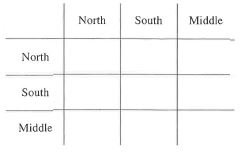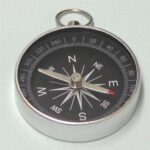Magnetic Exploration: Part 2: Finding Poles
Subject: Physics
Grade Level(s): Grade 4
Topic: Magnetism
Big Idea(s):
- Students know that magnets have two poles (north and south) and that like poles repel each other while unlike poles attract each other.
- Students know how to build a simple compass and use it to detect magnetic effects, including Earth’s magnetic field.
- Differentiate observation from inference (interpretation) and know scientists’ explanations come partly from what they observe and partly from how they interpret their observations.
- Formulate and justify predictions based on cause-and-effect relationships.
- Conduct multiple trials to test a prediction and draw conclusions about the relationships between predictions and results.
- Follow a set of written instructions for a scientific investigation.
What you need:
- Compass
- Magnet Kit
Grouping: Work in Groups of Two
Summary:
Finding Poles; is a guided inquiry activity where you will explore the dipole nature
of permanent magnets and see how magnetic poles interact.
Learning Goals / Objectives:
1.) Students will gain a hands on understanding of many properties of permanent magnets. In particular they will learn
- About magnetic poles and their interactions with each other
- How to visualize and measure magnetic fields
- What materials are magnetic and what materials are not magnetic
- How to characterize the field strength of a permanent magnet
Anticipatory Set:
Driving Questions
1.) How do magnets work?
2.) How does a compass work?
3.) How can we “see” magnetic fields?
Instructions / Activities:
In this activity we will use a compass to label the North and South poles of a few of the magnets in you magnet kit. A compass is a small bar magnet that is able to freely rotate. Because it can move freely, it will align with the biggest magnetic field it comes into contact with. The arrow will point to the North pole of a magnet and the Tail will point towards the South pole.
1.) Pick ~ 6 magnets from your magnet kit. Try to choose magnets with different shapes and sizes.
2.) Use a compass to locate and mark the North and South poles for each magnet. You may want to start with a labeled magnet. Any surprises?
3.) Systematically test the interactions between magnet poles of different magnets. Indicate attraction, repulsion, or no interaction for:
- North with North
- South with South
- North with South
- South with North
- South with the middle of a magnet (between South and North)
- North with the middle of a magnet (between South and North)
4.) Can you use your observations in 3 to:
- Label an unknown magnet North and South?
- Determine which pole the arrow is in your compass?
Follow up Questions:
1.) Write a general rule for how poles of a magnet interact.
2.) Did you ever observe a:
- Magnet with a South pole but no North pole?
- Magnet with a North pole but no South pole?
Assessment:
Teacher’s Discretion
Wrap-up / Closure:
Teacher’s Discretion
These materials are contained in a kit in our Library!



